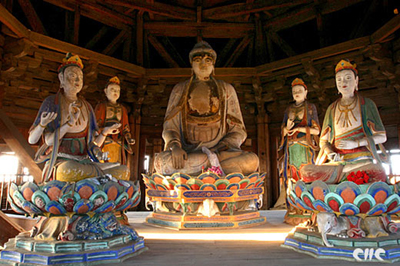Architecture wonder

There is another convincing reason for the pagoda's longevity: ingenious architecture.
Despite the fact that local annals record the pagoda's construction in 1056, no records show who constructed and why. Local people even choose to believe it was built by Lu Ban, China's legendary master carpenter of the Spring and Autumn period (770 - 476 BC).
The ancient craftsmanship dwarfs modern technology: 26 statues appear on different floors to represent different stages of enlightenment, from gold-leaf on the first floor to nine plain sculptures on the fifth floor. Not one nail is to be found in the entire structure.
The work is not just state-of-the-art architecture for the Liao Dynasty (916-1125), says Luo Zhewen, 82 and an expert from the State Administration of Cultural Heritage. It's state-of-the-art architecture for the 21st century, Luo adds.
Today, experts still rack their brains to work out how to fix the pagoda.
Luo leads the repair team, where three schools of thought contend. Some say it's only necessary to support the leaning parts; others say the upper levels above the third floor should be supported and finally there are those who argue that the whole building should be dismantled and built again.
There is usually an underground shrine below a pagoda. A repair team in 1993 identified a rectangular structure beneath the pagoda. Such an underground treasure trove should contain materials which would help decode the lost history of the ancient building.